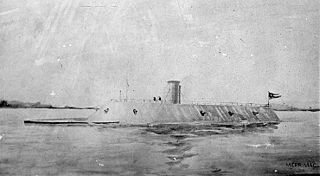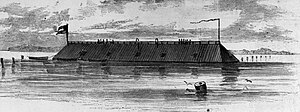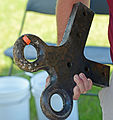
CSS Virginia was the first steam-powered ironclad warship built by the Confederate States Navy during the first year of the American Civil War; she was constructed as a casemate ironclad using the raised and cut down original lower hull and engines of the scuttled steam frigate USS Merrimack. Virginia was one of the participants in the Battle of Hampton Roads, opposing the Union's USS Monitor in March 1862. The battle is chiefly significant in naval history as the first battle between ironclads.

CSS Texas was the third and last Columbia-class casemate ironclad built for the Confederate Navy during the American Civil War. Not begun until 1864 and intended to become part of the James River Squadron, she saw no action before being captured by Union forces while still fitting out. CSS Texas was reputed to have been one of the very best constructed Confederate ironclads, second only to CSS Mississippi.

CSS Albemarle was a steam-powered ironclad gunboat ram of the Confederate Navy, named for a town and a sound in North Carolina. All three were named for General George Monck, the first Duke of Albemarle and one of the original Carolina Lords Proprietor.

CSSVirginia II was a Confederate Navy steam-powered ironclad ram laid down in 1862 at the William Graves' shipyard in Richmond, Virginia. Acting Constructor William A. Graves, CSN, was the superintendent in charge of her construction. In order to conserve scarce iron plating, he ordered the ship's armored casemate shortened from the specifications given in John L. Porter's original building plans; in addition, the ship's iron-plating, while six inches thick on the casemate's forward face, was reduced to five inches on her port, starboard, and aft faces. Due to the shortening of her casemate, the number of her cannon were reduced to a single 11" smoothbore, a single 8" rifle, and two 6.4" rifles.

Atlanta was a casemate ironclad that served in the Confederate and Union Navies during the American Civil War. She was converted from a British-built blockade runner named Fingal by the Confederacy after she made one run to Savannah, Georgia. After several failed attempts to attack Union blockaders, the ship was captured by two Union monitors in 1863 when she ran aground. Atlanta was floated off, repaired, and rearmed, serving in the Union Navy for the rest of the war. She spent most of her time deployed on the James River supporting Union forces there. The ship was decommissioned in 1865 and placed in reserve. Several years after the end of the war, Atlanta was sold to Haiti, but was lost at sea in December 1869 on her delivery voyage.
CSS Charleston was a casemate ironclad ram built for the Confederate Navy (CSN) at Charleston, South Carolina during the American Civil War. Funded by the State of South Carolina as well as donations by patriotic women's associations in the city, she was turned over to the Confederate Navy and defended the city until advancing Union troops that threatened Charleston caused her to be destroyed in early 1865 lest she be captured. Her wreck was salvaged after the war and the remains have been obliterated by subsequent dredging.
CSS North Carolina was a casemate ironclad built for the Confederate Navy in 1863 during the American Civil War by Berry & Brothers at Wilmington, North Carolina at a cost of $76,000. She was placed in commission during the latter part of the year with Commander W. T. Muse, CSN, in command.

CSS Tennessee was a casemate ironclad ram built for the Confederate Navy during the American Civil War. She served as the flagship of Admiral Franklin Buchanan, commander of the Mobile Squadron, after her commissioning. She was captured in 1864 by the Union Navy during the Battle of Mobile Bay and then participated in the Union's subsequent Siege of Fort Morgan. Tennessee was decommissioned after the war and sold in 1867 for scrap.

CSSRichmond, an ironclad ram, was built for use in the American Civil War at Gosport (Norfolk) Navy Yard to the design of John L. Porter with money and scrap iron collected by the citizens of Virginia, whose imagination had been captured by the ironclad CSS Virginia. Consequently, she was sometimes referred to as Virginia II, Virginia No. 2 or Young Virginia in the South and as Merrimack No. 2, New Merrimack or Young Merrimack by Union writers, months before the actual CSS Virginia II was ever laid down.

USS Carondelet (1861) was a City-class ironclad gunboat constructed for the War Department by James B. Eads during the American Civil War. It was named for the town where it was built, Carondelet, Missouri.
CSS Raleigh was a steam-powered Civil War casemate ironclad. She was fitted with a spar torpedo instead of an iron ram and was built in 1863–1864 by the Confederate States Navy at Wilmington, North Carolina. While she was being built her commander was Lieutenant John Wilkinson (CSN). She was put into commission on April 30, 1864 under the command of Lieutenant J. Pembroke Jones, CSN.

CSS Savannah was a Richmond-class casemate ironclad in the Confederate States Navy during the American Civil War.

The Siege of Fort Pulaski concluded with the Battle of Fort Pulaski fought April 10–11, 1862, during the American Civil War. Union forces on Tybee Island and naval operations conducted a 112-day siege, then captured the Confederate-held Fort Pulaski after a 30-hour bombardment. The siege and battle are important for innovative use of rifled guns which made existing coastal defenses obsolete. The Union initiated large-scale amphibious operations under fire.

The National Civil War Naval Museum, located in Columbus, Georgia, United States, is a 40,000-square-foot (3,700 m2) facility that features remnants of two Confederate States Navy vessels. It also features uniforms, equipment and weapons used by the United States (Union) Navy from the North and the Confederate States Navy forces. It is claimed to be the only museum in the nation that tells the story of the two navies during the Civil War.

CSS Muscogee was an casemate ironclad built for the Confederate States Navy during the American Civil War in Columbus, Georgia. Her original paddle configuration was judged unsuccessful when she could not be launched on the first attempt in 1864 and she had to be rebuilt to use propellers. Later renamed CSS Jackson and armed with four 7-inch (178 mm) and two 6.4-inch (163 mm) guns, she was captured while still fitting out and was set on fire by Union troops in April 1865. Her wreck was salvaged in 1962–1963 and turned over to the National Civil War Naval Museum in Columbus for display. The ironclad's remains were listed on the National Register of Historic Places in 1970.

The casemate ironclad was a type of iron or iron-armored gunboat briefly used in the American Civil War by both the Confederate States Navy and its adversary, the Union Navy. Compared to the turreted ironclad warships that became standard, the casemate ironclad did not have its individual cannons encased in a separate armored gun deck/turret, but instead had a single casemate structure, or armored citadel, on the main deck housing the entire gun battery. As the guns were carried on the top of the ship yet still fired through fixed gunports, the casemate ironclad is seen as an intermediate stage between the traditional broadside frigate and the modern warships.

CSS Neuse was a steam-powered ironclad ram of the Confederate States Navy that served in the latter part the American Civil War and was eventually scuttled to avoid capture by rapidly advancing Union Army forces. In the early 1960s, she produced approximately 15,000 artifacts from her raised lower hull, the largest number ever found on a recovered Confederate vessel. The remains of her lower hull and a selection of her artifacts are on exhibit in Kinston, North Carolina at the CSS Neuse Interpretive Center State Historic Site, which belongs to the North Carolina Department of Natural and Cultural Resources. The ironclad is listed on the National Register of Historic Places.
The CSS Peedee, also known as the CSS Pee Dee was a Confederate gunboat launched in January 1865 and scuttled the following month during the American Civil War.
CSS Missouri was a Confederate States Navy casemate ironclad paddle steamer deployed on the Red River during the American Civil War. For most of the war she was trapped in the Shreveport, Louisiana area by low water on the Red River. The ship was surrendered in June 1865 to the United States Navy and sold in November.

CSS Wilmington was an unnamed casemate ironclad built for the Confederate States Navy during the American Civil War. The ship was never officially named and is referred to by historians by the name of the city in which she was built. Wilmington was still under construction during the February 1865 Battle of Wilmington and was destroyed to prevent her capture by Union troops after their victory.























